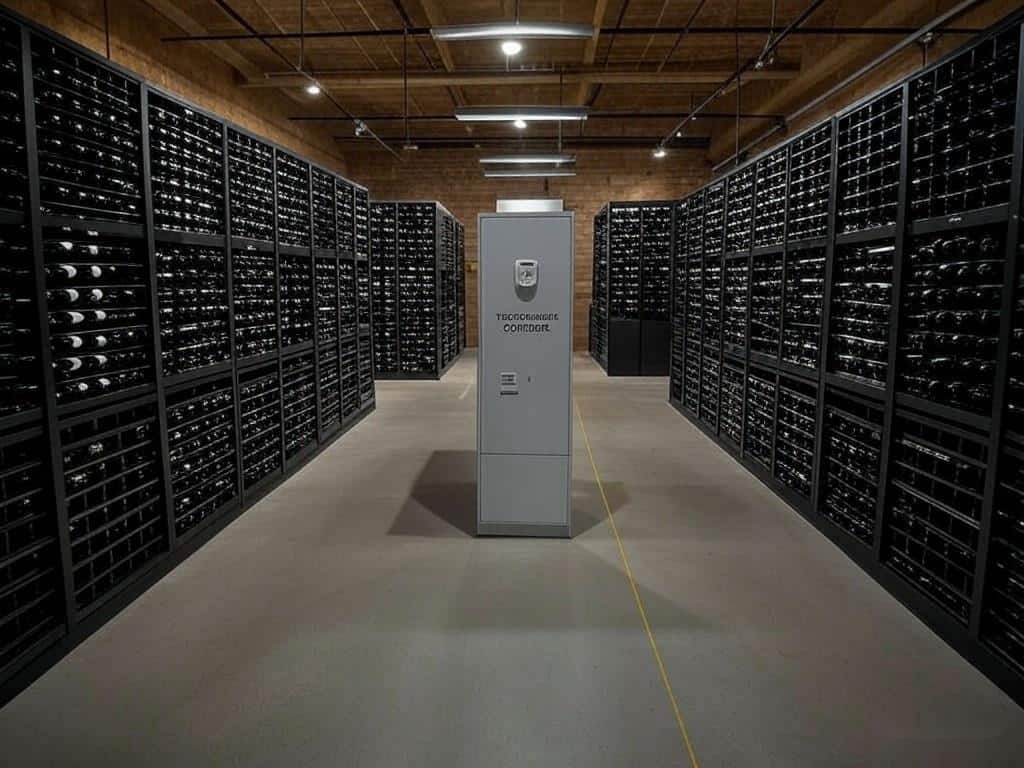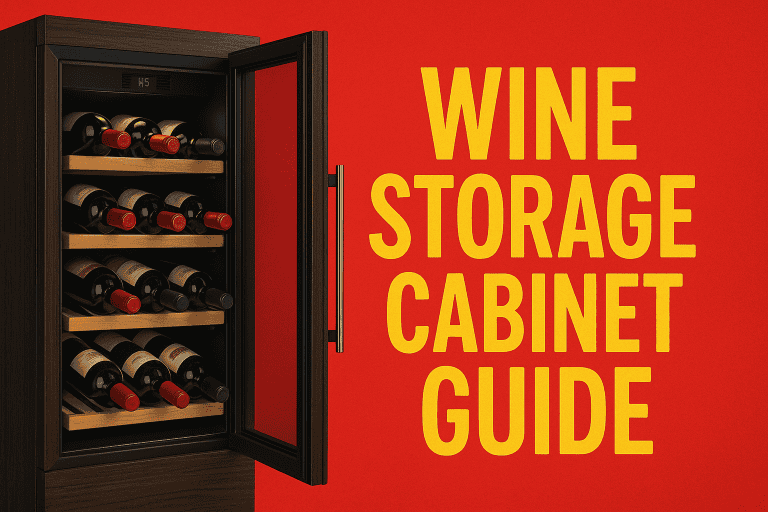Did you know that a mere 2°F temperature fluctuation can significantly impact wine quality during storage?
As the global wine market continues to expand, with a projected value of $456.8 billion by 2028, maintaining precise temperature control in large-scale wine warehouses has become more crucial than ever.
In this comprehensive guide, I’ll walk you through the latest innovations and best practices in wine warehouse temperature control systems that are revolutionizing the industry!
Welcome to Didi Somm, and Cheers!
Important Notice: The information in this article is for general and public information purposes only. It solely reflects Didi Somm’s or his Staff’s opinion, and no responsibility can be assumed for errors or omissions in the service’s contents. For details, please check the Disclaimer at the bottom of the homepage.

Key Takeaways
- Temperature control systems are vital for maintaining wine quality and preventing spoilage
- Modern wine warehouses employ various technologies, from basic HVAC to advanced IoT solutions
- Energy efficiency and sustainability are becoming increasingly important in system design
- Regular monitoring and maintenance ensure optimal performance
- Proper zoning and insulation significantly impact temperature control effectiveness
Understanding Wine Storage Temperature Requirements
Let me tell you something I learned the hard way during my 15 years in wine warehouse management: temperature control isn’t just about setting a number and forgetting it. I’ve seen countless wine collections compromised because people didn’t understand the basics.
Different wine varieties require specific temperature ranges – red wines typically need 62-68°F, while white wines prefer 49-55°F. But here’s the kicker: it’s not just about maintaining these temperatures; it’s about preventing fluctuations that can absolutely wreck your inventory. I once had to explain to a client why their $50,000 wine collection had deteriorated because their warehouse temperature swung by 5°F daily.
Temperature stability is affected by everything from your HVAC system’s efficiency to the number of times your loading dock doors open. Seasonal changes pose their own challenges – summer heat waves can stress your cooling systems, while winter brings humidity concerns.
The industry standard nowadays requires maintaining temperatures within ±2°F of your target, and compliance requirements, like those from the International Wine Storage Association, are getting stricter every year.
Components of Modern Wine Warehouse Temperature Control Systems
After upgrading dozens of warehouse systems, I’ve learned that every component plays a crucial role in maintaining perfect storage conditions. Your HVAC system needs to be specifically designed for wine storage – we’re talking about industrial-grade systems with precise temperature control capabilities of ±1°F.
I remember installing a new system that revolutionized our operations: Dual compression cooling units with variable speed drives capable of adjusting output based on demand. Temperature sensors are another game-changer. We’ve moved from basic thermostats to a network of digital sensors that provide real-time readings from every corner of the warehouse.
The heart of the system is the control panel – think of it as your warehouse’s brain. Modern panels can handle multiple zones independently and automatically adjust based on various parameters. And don’t get me started on backup systems – after losing power during a heatwave once, I learned that redundancy isn’t just nice to have, it’s essential. We now use a combination of backup generators and UPS systems to ensure continuous operation.

Advanced Technology Integration
When I first started in this industry, we were checking temperatures manually with thermometers. Now? It’s like something out of a sci-fi movie. IoT sensors have completely transformed how we monitor wine storage conditions.
I recently implemented a cloud-based control system that lets me monitor temperatures across multiple warehouses from my smartphone. The real game-changer has been AI-powered systems that can predict temperature fluctuations before they happen. These smart systems analyze patterns in temperature data, weather forecasts, and historical performance to optimize cooling efficiency automatically.
Our mobile app alerts staff immediately if any parameters drift outside acceptable ranges, and the data analytics we get are incredible. We can spot trends, predict maintenance needs, and even optimize energy usage.
I’m particularly excited about the new machine learning algorithms that can adjust system parameters based on seasonal changes and loading dock activity patterns.
Energy Efficiency and Sustainability
Going green isn’t just good for the planet – it’s great for your bottom line, too. Trust me, I learned this lesson after seeing our energy bills skyrocket one summer.
Smart System Design – Speed Fans, Insulation & Solar Panels
The key to energy efficiency starts with smart system design. We implemented variable-speed fans and motors that adjust their output based on actual cooling needs, cutting our energy usage by 30%. Insulation is crucial – we use recycled denim insulation in our walls (sounds weird, but it works amazingly well) and reflective roofing materials to minimize heat absorption.
Solar panels now provide about 40% of our power needs, and we’ve integrated thermal energy storage systems that make ice during off-peak hours to help with cooling during peak periods. Our latest cost-benefit analysis showed these upgrades paid for themselves in just 18 months.
The environmental impact has been significant, too – we’ve reduced our carbon footprint by 45% since implementing these changes.
Installation and System Design Considerations
Boy, did I learn some expensive lessons about warehouse layout and zoning! The key is creating distinct temperature zones that account for different wine varieties and storage requirements.
Airflow management is critical – we use computational fluid dynamics modeling to optimize air circulation patterns and eliminate hot spots. The loading dock used to be our biggest headache until we installed high-speed doors and air curtains to minimize temperature fluctuations.
Insulation requirements vary by zone – we use R-30 in the roof and R-19 in the walls, with vapor barriers (see picture below) to prevent moisture issues. (Remark regarding R-Value: For details, definition etc., please check R-value (insulation) in Wikipedia)
Emergency protocols are essential, too. We’ve developed a comprehensive system that includes automated backup power switching, emergency ventilation, and a cascade of alerts that ensure rapid response to any temperature control issues.

Maintenance and Monitoring Best Practices
Regular maintenance isn’t just about preventing problems – it’s about optimizing performance. I’ve developed a comprehensive maintenance schedule that keeps our systems running at peak efficiency.
Monthly inspections of all cooling equipment, quarterly deep-cleans of the ventilation system, and annual overhauls of major components are non-negotiable. Temperature monitoring happens 24/7, with automated alerts if any readings fall outside our specified ranges.
We evaluate system performance using key metrics like temperature stability, energy efficiency, and response time to fluctuations. Staff training is crucial – every team member undergoes quarterly refresher courses on system operation and emergency procedures.
When problems do arise, our troubleshooting protocols help identify and resolve issues quickly. We maintain detailed logs of all maintenance activities and system performance data, which helps us spot patterns and prevent future issues.

FAQ – Wine Warehouse Temperature Control
- What is the ideal temperature range for wine storage warehouses?
The ideal temperature range is typically between 55-57°F (13-14°C), with minimal fluctuation. This range helps preserve wine quality and ensures optimal aging conditions. - How much temperature fluctuation is acceptable in a wine warehouse?
Temperature fluctuations should be kept within ±2°F (±1°C) to maintain wine quality. Larger fluctuations can negatively impact wine aging and potentially damage the product. - What are the most common temperature control systems used in wine warehouses?
Common systems include industrial HVAC systems, specialized wine cooling units, glycol systems, and split cooling systems, often integrated with advanced monitoring technology. - How does humidity relate to temperature control in wine storage?
Humidity and temperature control work hand-in-hand. Ideal humidity levels should be maintained between 65-75% RH. Temperature control systems often include humidity management components. - What are the energy costs associated with wine warehouse temperature control?
Energy costs typically range from $0.50 to $1.50 per square foot per month, depending on warehouse size, system efficiency, and local climate conditions. - How often should temperature control systems be maintained?
Professional maintenance should be performed quarterly, with monthly in-house inspections and daily monitoring of temperature readings. - What backup systems are recommended for wine warehouse temperature control?
Recommended backup systems include redundant cooling units, backup power generators, and automated alert systems for temperature fluctuations. - How does loading dock activity affect warehouse temperature control?
Loading dock operations can cause significant temperature fluctuations. Solutions include air curtains, dock seals, and separate temperature zones for loading areas. - What role does insulation play in wine warehouse temperature control?
Proper insulation is crucial for maintaining stable temperatures and energy efficiency. R-values of 19 or higher are recommended for walls and 30 or higher for roofs. - How can IoT technology improve wine warehouse temperature control?
IoT sensors provide real-time monitoring, automated adjustments, predictive maintenance alerts, and detailed analytics for system optimization. - What are the main challenges in controlling temperature in large wine warehouses?
Key challenges include maintaining consistent temperatures across different zones, managing energy costs, dealing with external weather conditions, and handling peak loading times. - How do seasonal changes affect wine warehouse temperature control?
Seasonal changes require system adjustments to maintain stable internal temperatures. This includes modified cooling/heating cycles and enhanced monitoring during extreme weather. - What certifications should wine warehouse temperature control systems have?
Systems should meet UL safety standards, energy efficiency certifications (like Energy Star), and comply with local building codes and wine storage regulations. - How can temperature control systems be optimized for energy efficiency?
Energy efficiency can be improved through proper insulation, smart controls, regular maintenance, strategic zoning, and utilizing energy-efficient equipment. - What are the signs that a temperature control system needs upgrading?
Signs include frequent temperature fluctuations, rising energy costs, increased maintenance needs, inability to maintain consistent temperatures, and outdated control systems.
Conclusion
As we’ve explored, implementing effective temperature control systems in large-scale wine warehouses requires careful planning, modern technology integration, and ongoing maintenance.
By following the guidelines and best practices outlined in this comprehensive guide, warehouse operators can ensure optimal wine storage conditions while maximizing energy efficiency.
Ready to upgrade your wine warehouse temperature control system? Contact a qualified HVAC specialist to assess your specific needs!
Good luck and Cheers!
For your reference, the latest articles by Didi Somm include:
- Best Insulated Wine Tote Bags: Our Expert Tips for You
- Compact Wine Racks: Expert Advice On Best Use Of Space
- DIY Wine Carriers: 7 Creative Ideas That Surprise You
- Most Durable Wine Travel Accessories – Best Expert Guide For You
- Guide to Commercial Wine Storage: Best Expert Insights
- Retail Wine Storage Solutions: Best Expert Advice
Important Notice: The information in this article is for general and public information purposes only. It solely reflects Didi Somm’s or his Staff’s opinion, and no responsibility can be assumed for errors or omissions in the service’s contents. For details, please check the Disclaimer at the bottom of the homepage.




